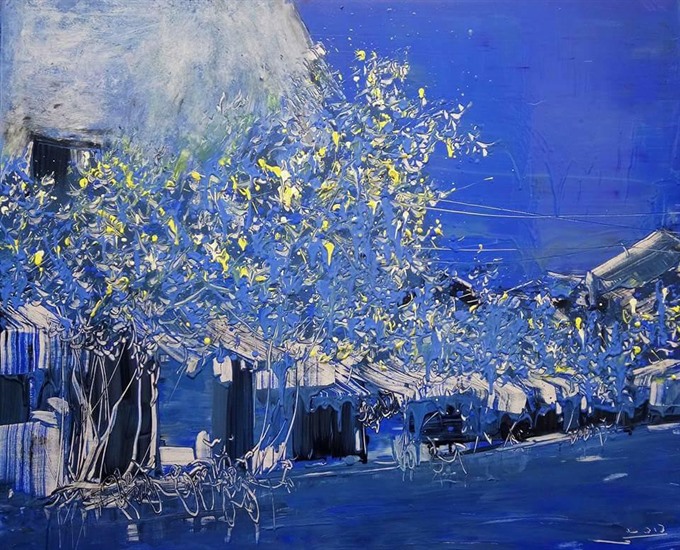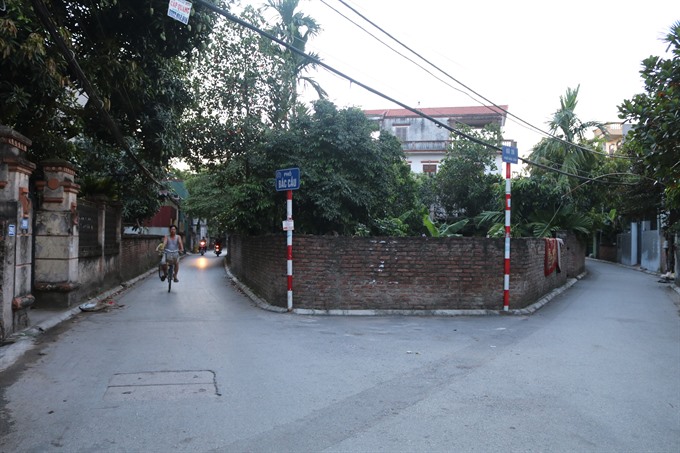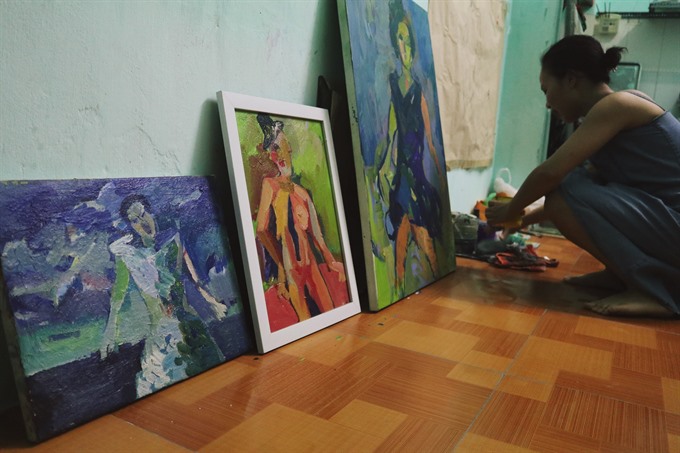 Features
Features

Hidden away just short moped ride from downtown Hà Nội is a place of peace. Bắc Cầu Street just across Long Biên Bridge is where artists meet, paint and in some cases live.
 |
| "Hội An on a rainy day" by Hùng, the painting has been sold at US$5,200 and the cash has been donated to a charity that provides free surgery to children. Photo courtesy of the artist |
by Mai Phương
Hidden away just short moped ride from downtown Hà Nội is a place of peace.
Around 70 painters from different parts of the country call this place home.
Once inside this quaint village, the dust seems to lift and is replaced by the natural sweet aromas from the fruit trees lining the gardens of the old-style three-storey houses that make this area so special.
If you can’t find it, a quick search of Google maps will reveal its location just seven kilometres from the hustle and bustle of Hà Nội. And when you see the shape of the area, you may believe it was meant to be a home for artists, as some say it almost resembles the outline of a paint brush.
But it’s not just the natural beauty or the trees that make
Talking with the ’trio of talent’ - Bùi Hoàng Dương, Nguyễn Mạnh Hùng (aka Hùng Rô) and Nguyễn Minh Phương -- helps me understand and appreciate not only their amazing abilities, but also how they draw inspiration from their surroundings.
I become lost and almost transported to a forest overgrown with bright and beautiful colours during my private view at their work.
Although equally as impressive as his peers, Hùng’s own style is more abstract, using greys and dark tones to depict a house on the river. I could almost hear the birds he paints come alive as they sing their morning chorus.
And Dương’s work also takes inspiration from animals. But the dogs he draws seem more human, while Phương is focussing on featuring women’s spiritual life.
“The village is not very far from the downtown modern Hà Nội but it has scenery very similar to typical countryside, which can easily inspire artists’ emotion,” said Dương.
His house is small and in the style of days gone by. But the walls come alive with the many paintings of dogs that adorn them.
Dương, who came from Mường ethnic minority in the central province of Thanh Hóa, has lived in Bắc Cầu (North Bridge) Street for five years and he is very much in love with the street. He said it was not only a land for shelter but also a land for creation.
He said there are many creative minds living in the street. Sculptors and architects can be found alongside painters, who make up the majority.
Hùng Rô, who has been living in the street for more than seven years, said that after some ups and downs in his life, he could not live anywhere else except Bắc Cầu.
This is where he calls home.
“The reason why I choose to live here is that I can have a chance to be close to nature. It is very important to get inspiration for my work,” he said, listing the many things that inspire him: the two rivers, birds and gardens, to name just a few.
Born in 1984 in the
 |
| Bắc Cầu Street is where artists meet, paint and in some cases live. |
 |
| Painter Nguyễn Minh Phương is one of the few female artists in Hà Nội who faithfully practises nude painting. |
 |
| "Love" by painter Bùi Hoàng Dương. His work takes inspiration mostly from dogs. |
In the past few weeks he sold a piece for more than US$5,000. That money would have gone a long way for his family, but instead he donated it to a charity that provides free healthcare for the disadvantaged.
Art is all that matters to Hùng Rô. He lives and breathes it. And the things most of us take for granted everyday are the things he paints.
“The wind blowing, the sun shining and birds singing,” he said. “These are the things that inspire me. Using colours to reveal emotions is the best way to describe my work.”
“I try to get close to the flashes of emotions that come to mind. I want to capture them, bring them closer to me and express those feelings through my work.”
Phương is one of rare female artists in Hà Nội who faithfully practises nude painting. Most of her work focuses on the body of a woman, which she said could convey their spiritual lives.
From the neighbouring province of Hưng Yên, she also chose Bắc Cầu to live and work. because she wanted to be close to nature and particularly to her artistic colleagues. She is now also working as an art teacher for children living in the community.
According to Bùi Xuân Đính, an expert on traditional culture, particularly village culture in the early 19th century, Bắc Cầu belonged to Đông Ngàn Commune of the then Bắc Ninh Province.
At the beginning of the nation’s resistance war against the French in 1946, the village was merged with others including Bắc Biên, Gia Thượng and Gia Quất to make up Ngọc Thụy Commune, which now is part of Long Biên District.
Traditionally, rivers provided sources of fresh water, bringing good luck to the villagers and gifting them with a beautiful landscape.
The two rivers of Hồng and Đuống also brought fertile silt to the land. Although there were not many large fields, the villagers there could earn a stable living by growing mulberries and silkworms, planting food crops and fishing while picking firewood on the river banks.
However, in rainy seasons, the river water level rose to cause floods that in the past destroyed homes and crops. During such hard times, maybe several months a year, villagers suffered food shortage.
According to Đính the village has two ancient pagodas of Long Đọi and Thuận Lợi, with various valuable historical relics including two old-style bells made in 1698 and 1894 and many statues of 18th century.
From a damp and muddy village, today Bắc Cầu is being constantly urbanised. All of the roads now have been laid with asphalt and tall buildings are rising.
Many fear this oasis of artistic tranquility is in danger of losing its tranquillity as it fights modernisation and construction work all around.
But whatever changes are made to the outside world, those who live and work in Bắc Cầu will always paint from within their hearts and souls. VNS




